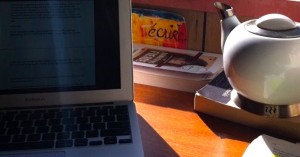‘There Must be Tea. And a Window.’
 Tea in hand, I scribble in notebooks with a pen. I use a laptop when lines begin coming together; my laptop and I move from room to room, sometimes right out the front door to a café where none of the noises are my responsibility. I write for an hour a day, or five hours, or eight. Sometimes not at all.
Tea in hand, I scribble in notebooks with a pen. I use a laptop when lines begin coming together; my laptop and I move from room to room, sometimes right out the front door to a café where none of the noises are my responsibility. I write for an hour a day, or five hours, or eight. Sometimes not at all.
I draw maps of the various venues where a story’s action occurs, the places my characters inhabit. I’ll draw rooms in an apartment, marking where doors and windows are located, where furniture sits. I’ll map out patterns of urban streets and country roads, or the layout of a store or a pub, or the location of rocks and trees at the edge of a lake. I keep notes on a character’s eye colour, style of hair, significant dates, background details. This is to ensure, for example, that a protagonist with small brown eyes, will not be encountered halfway through the narrative, staring up into her lover’s face with big blue eyes.
As I mentioned, on a writing day, there must be tea. Best is a full pot. And best if there’s a window providing light and dark that shifts the life outside. Never a Zen like stare at the wall for me.
I learn to write by writing. I read the fiction of other writers with an apprentice’s ear and eye. I want to know how a story is being made, how a narrative is taking shape, what makes it cohesive and authentic, or what causes it to fall apart.
I learn my craft too, from conversations with other book lovers about all things literary. I follow established authors’ observations about their own writing process.
Here’s Alice Munro on building a story “…out of its own necessity…” .
“A story is not like a road to follow … it’s more like a house. You go inside and stay there for a while, wandering back and forth and settling where you like and discovering how the room and corridors relate to each other, how the world outside is altered by being viewed from these windows. And you, the visitor, the reader, are altered as well by being in this enclosed space, whether it is ample and easy or full of crooked turns, or sparsely or opulently furnished. You can go back again and again, and the house, the story, always contains more than you saw the last time. It also has a sturdy sense of itself of being built out of its own necessity, not just to shelter or beguile you.” ALICE MUNRO
Alice Munro’s concept of building a story ‘out of its own necessity’ is a challenging one for me. Her insights are those of a master. I pay attention. In this way, my life as a student of writing, as a creator learning to embrace successes and failures, is constantly nourished.
I hold on to a belief that collectively, our creative offerings are a rally against destructiveness, that they have the power to link hearts and minds across false barriers to our shared humanity.
Thanks for visiting my website. I hope you enjoy browsing, that you find something here to spark your interest.
Excerpt from a talk at The Heliconian Literary Lecture Series in Toronto 2006:
“My characters are often searching for ways to inhabit our increasingly turbulent world. At times of upheaval in their own lives, they may experience themselves as strangers alienated from their environment, perhaps in an exotic culture, or in the midst of what has been familiar all their lives. Some event will jar their sense of reality. The question of how to navigate in foreign territory often leads to an opening, and the essential spark of creativity that is needed to deepen understanding, to find new meaning. If this sounds like a cliche, perhaps it is, but most clichés get that way because they ring true so many times, and I think it’s the job of the artist, the writer, and here’s another cliché, to “make something new of something old.”
“My characters are not me, although they will always contain elements of me, and their stories are not my stories, although I draw on my own experience. Transforming experience, and assigning it to an imagined character, creates just that, an imagined character whose narrative will move through an imaginary plot. If one plants a seed in fertile ground, it doesn’t remain a seed for long, but will grow into something that bears little resemblance to the seed.”
